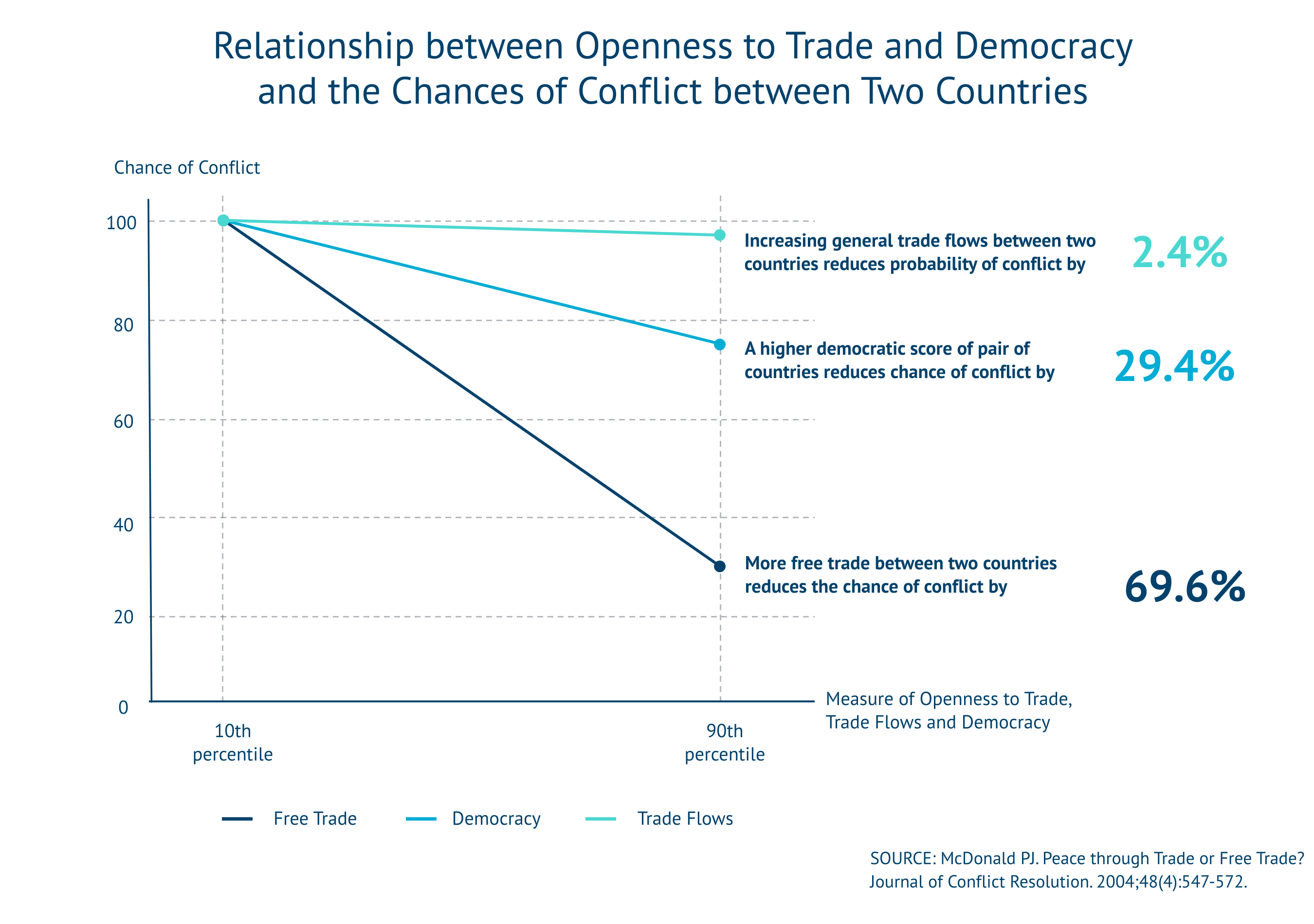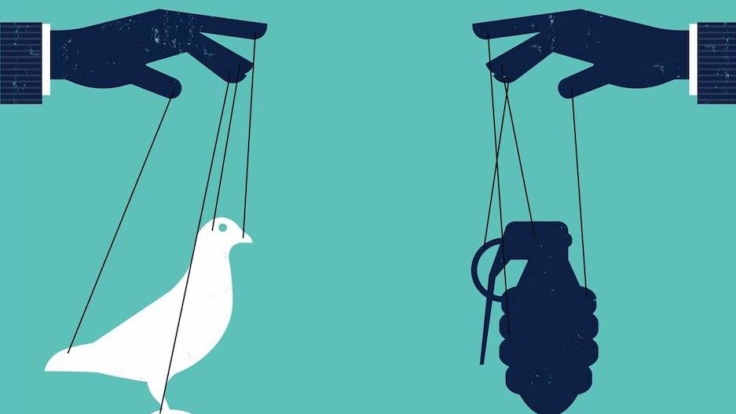Published 10 September 2020
Why does protectionism lead to conflict and why does free trade help prevent it? Learn about the connection between peace and free trade.
Frédéric Bastiat famously claimed that “if goods don’t cross borders, soldiers will.”
Bastiat argued that free trade between countries could reduce international conflict because trade forges connections between nations and gives each country an incentive to avoid war with its trading partners. If every nation were an economic island, the lack of positive interaction created by trade could leave more room for conflict. Two hundred years after Bastiat, libertarians take this idea as gospel. Unfortunately, not everyone does. But as recent research shows, the historical evidence confirms Bastiat’s famous claim.
To trade or to raid
In “Peace through Trade or Free Trade?” professor Patrick J. McDonald, from the University of Texas at Austin, empirically tested whether greater levels of protectionism in a country (tariffs, quotas, etc.) would increase the probability of international conflict in that nation. He used a tool called dyads to analyze every country’s international relations from 1960 until 2000. A dyad is the interaction between one country and another country: German and French relations would be one dyad, German and Russian relations would be a second, French and Australian relations would be a third. He further broke this down into dyad-years; the relations between Germany and France in 1965 would be one dyad-year, the relations between France and Australia in 1973 would be a second, and so on.
Using these dyad-years, McDonald analyzed the behavior of every country in the world for the past 40 years. His analysis showed a negative correlation between free trade and conflict: The more freely a country trades, the fewer wars it engages in. Countries that engage in free trade are less likely to invade and less likely to be invaded.

The causal arrow
Of course, this finding might be a matter of confusing correlation for causation. Maybe countries engaging in free trade fight less often for some other reason, like the fact that they tend also to be more democratic. Democratic countries make war less often than empires do. But McDonald controls for these variables. Controlling for a state’s political structure is important, because democracies and republics tend to fight less than authoritarian regimes.
McDonald also controlled for a country’s economic growth, because countries in a recession are more likely to go to war than those in a boom, often in order to distract their people from their economic woes. McDonald even controlled for factors like geographic proximity: It’s easier for Germany and France to fight each other than it is for the United States and China, because troops in the former group only have to cross a shared border.
The takeaway from McDonald’s analysis is that protectionism can actually lead to conflict. McDonald found that a country in the bottom 10 percent for protectionism (meaning it is less protectionist than 90 percent of other countries) is 70 percent less likely to engage in a new conflict (either as invader or as target) than one in the top 10 percent for protectionism.

Protectionism and war
Why does protectionism lead to conflict, and why does free trade help to prevent it? The answers, though well-known to classical liberals, are worth mentioning.
First, trade creates international goodwill. If Chinese and American businessmen trade on a regular basis, both sides benefit. And mutual benefit disposes people to look for the good in each other. Exchange of goods also promotes an exchange of cultures. For decades, Americans saw China as a mysterious country with strange, even hostile values. But in the 21st century, trade between our nations has increased markedly, and both countries know each other a little better now. iPod-wielding Chinese teenagers are like American teenagers, for example. They’re not terribly mysterious. Likewise, the Chinese understand democracy and American consumerism more than they once did. The countries may not find overlap in all of each other’s values, but trade has helped us to at least understand each other.
Trade helps to humanize the people that you trade with. And it’s tougher to want to go to war with your human trading partners than with a country you see only as lines on a map.
Second, trade gives nations an economic incentive to avoid war. If Nation X sells its best steel to Nation Y, and its businessmen reap plenty of profits in exchange, then businessmen on both sides are going to oppose war. This was actually the case with Germany and France right before World War I. Germany sold steel to France, and German businessmen were firmly opposed to war. They only grudgingly came to support it when German ministers told them that the war would only last a few short months. German steel had a strong incentive to oppose war, and if the situation had progressed a little differently—or if the German government had been a little more realistic about the timeline of the war—that incentive might have kept Germany out of World War I.

Third, protectionism promotes hostility. This is why free trade, not just aggregate trade (which could be accompanied by high tariffs and quotas), leads to peace. If the United States imposes a tariff on Japanese automobiles, that tariff hurts Japanese businesses. It creates hostility in Japan toward the United States. Japan might even retaliate with a tariff on US steel, hurting US steel makers and angering our government, which would retaliate with another tariff. Both countries now have an excuse to leverage nationalist feelings to gain support at home; that makes outright war with the other country an easier sell, should it come to that.
In socioeconomic academic circles, this is called the Richardson process of reciprocal and increasing hostilities; the United States harms Japan, which retaliates, causing the United States to retaliate again. History shows that the Richardson process can easily be applied to protectionism. For instance, in the 1930s, industrialized nations raised tariffs and trade barriers; countries eschewed multilateralism and turned inward. These decisions led to rising hostilities, which helped set World War II in motion.
These factors help explain why free trade leads to peace, and protectionism leads to more conflict.
Free trade and peace
One final note: McDonald’s analysis shows that taking a country from the top 10 percent for protectionism to the bottom 10 percent will reduce the probability of future conflict by 70 percent. He performed the same analysis for the democracy of a country and showed that taking a country from the top 10 percent (very democratic) to the bottom 10 percent (not democratic) would only reduce conflict by 30 percent.
Democracy is a well-documented deterrent: The more democratic a country becomes, the less likely it is to resort to international conflict. But reducing protectionism, according to McDonald, is more than twice as effective at reducing conflict than becoming more democratic.
Here in the United States, we talk a lot about spreading democracy. We invaded Iraq partly to “spread democracy.” A New York Times op-ed by Professor Dov Ronen of Harvard University claimed that “the United States has been waging an ideological campaign to spread democracy around the world” since 1989. One of the justifications for our international crusade is to make the world a safer place.
Perhaps we should spend a little more time spreading free trade instead. That might really lead to a more peaceful world.
This article was originally published on FEE.org.
© The Hinrich Foundation. See our website Terms and conditions for our copyright and reprint policy. All statements of fact and the views, conclusions and recommendations expressed in this publication are the sole responsibility of the author(s).

